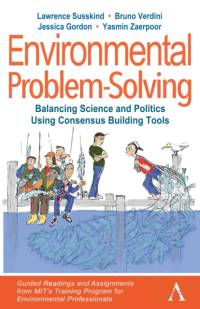Environmental Problem-Solving: Balancing Science and Politics Using Consensus Building Tools
- Guided Readings and Assignments from MIT's Training Program for Environmental Professionals
- Indbinding:
- Hardback
- Sideantal:
- 506
- Udgivet:
- 31. oktober 2020
- Størrelse:
- 237x159x39 mm.
- Vægt:
- 900 g.
- Ukendt - mangler pt..
Normalpris
Abonnementspris
- Rabat på køb af fysiske bøger
- 1 valgfrit digitalt ugeblad
- 20 timers lytning og læsning
- Adgang til 70.000+ titler
- Ingen binding
Abonnementet koster 75 kr./md.
Ingen binding og kan opsiges når som helst.
- 1 valgfrit digitalt ugeblad
- 20 timers lytning og læsning
- Adgang til 70.000+ titler
- Ingen binding
Abonnementet koster 75 kr./md.
Ingen binding og kan opsiges når som helst.
Beskrivelse af Environmental Problem-Solving: Balancing Science and Politics Using Consensus Building Tools
The book is divided into four sections: The first section focuses on how certain environmental problems can only be solved through active government efforts to implement policies that effectively take science and politics into account. This section introduces readers to foundational concepts, including the steps in the US federal environmental policy-making process, and offers an action-oriented analysis of how environmental policy gets implemented and how practitioners can use comparative analysis of public policy in environmental problem-solving. It concludes with questions about the possibility of a unified theory of environmental policy making. The section empowers readers to develop, through carefully designed assignments, a framework to shape an action plan to solve specific environmental problems.
The next section focuses on formulating a sound philosophical basis for taking action in environmental problem-solving situations. This includes a discussion of several ethical frameworks that practitioners can use to underpin the actions they propose. This section begins with a general overview of environmental ethics, and then moves to a discussion of utilitarianism versus intrinsic value, deep green approaches to environmental problem-solving, the debate over sustainability versus economic growth, and how science and indigenous knowledge can be applied in a wide range of environmental problem-solving situations. The section empowers readers to take a stand on these debates, drawing on practical cases with worked examples.
The penultimate section helps environmental practitioners understand how to use various analytical tools. It includes a quick survey of traditional and non-traditional evaluation techniques, discussing the strengths and weaknesses of each, focusing on environmental impact assessment, cost-benefit analysis, ecosystem services analysis, risk assessment, simulation and modeling, and scenario planning. This section prepares readers to practice multi-party environmental problem-solving, and to identify the power of each tool to enhance environmental problem-solving, developing the judgment to enumerate strengths and weaknesses as they see them playing out in practice.
The concluding section is a survey of the theory and practice behind mobilizing support for particular problem-solving efforts. It includes discussions of democratic decision-making and environmental problem solving, how the public can be brought in as a partner, methods of collaborative decision-making, the idea of consensus building, and how politics and power sway collective action efforts.
The next section focuses on formulating a sound philosophical basis for taking action in environmental problem-solving situations. This includes a discussion of several ethical frameworks that practitioners can use to underpin the actions they propose. This section begins with a general overview of environmental ethics, and then moves to a discussion of utilitarianism versus intrinsic value, deep green approaches to environmental problem-solving, the debate over sustainability versus economic growth, and how science and indigenous knowledge can be applied in a wide range of environmental problem-solving situations. The section empowers readers to take a stand on these debates, drawing on practical cases with worked examples.
The penultimate section helps environmental practitioners understand how to use various analytical tools. It includes a quick survey of traditional and non-traditional evaluation techniques, discussing the strengths and weaknesses of each, focusing on environmental impact assessment, cost-benefit analysis, ecosystem services analysis, risk assessment, simulation and modeling, and scenario planning. This section prepares readers to practice multi-party environmental problem-solving, and to identify the power of each tool to enhance environmental problem-solving, developing the judgment to enumerate strengths and weaknesses as they see them playing out in practice.
The concluding section is a survey of the theory and practice behind mobilizing support for particular problem-solving efforts. It includes discussions of democratic decision-making and environmental problem solving, how the public can be brought in as a partner, methods of collaborative decision-making, the idea of consensus building, and how politics and power sway collective action efforts.
Brugerbedømmelser af Environmental Problem-Solving: Balancing Science and Politics Using Consensus Building Tools
Giv din bedømmelse
For at bedømme denne bog, skal du være logget ind.
Find lignende bøger
Bogen Environmental Problem-Solving: Balancing Science and Politics Using Consensus Building Tools findes i følgende kategorier:








